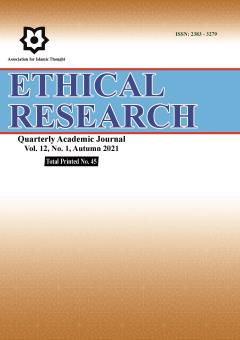Optimal marketing behaviors and its impact on the development of Internet TV (Case study: Audience of ordinary TV and Internet TV in Isfahan)
Subject Areas : Social ethics and behavioral modelingZahra Askari 1 , Esmaeil Hasanpour 2 , Mohammad Hossein Ranjbar 3 , Serajedin Mohebi 4
1 -
2 -
3 -
4 -
Keywords: Dimensions of marketing approach, Internet TV, Optimal behaviors.,
Abstract :
This study seeks to represent and measure the impact of the dimensions of the marketing approach on the development of Internet TV in the form of a conceptual model. Therefore, in this research, according to the research model, twelve hypotheses have been proposed. This research is applied in terms of purpose and is descriptive-survey with correlation approach in terms of implementation. The statistical population of the present study is 384 Internet TV audiences in Isfahan. Due to the unlimited statistical population, the Cochran's formula was used. For data collection, a standard questionnaire with 58 questions was used, the validity of which was obtained using the opinion of the tutor and the first confirmatory factor analysis and its reliability was obtained through Cronbach's alpha index (0.93). The collected data were analyzed by SPSS and PLS software. Based on the results, all research hypotheses were confirmed.
افخمی، حسین. حسام پور، محمد. (1399). چالش های تلویزیون ایران در مواجهه با تحولات فناورانه دیجیتال. فصلنامه علمی رسانه های دیداری و شنیداری. سال چهاردهم. شماره 1. پیاپی 33. صص 155-115.
حاتمی، امیر، روشندل، طاهر، شریفی، مهدی، قلیچ¬لی، بهروز. (1398). بررسی نقش قابلیت¬های فناوری در پیاده سازی موفق نوآوری باز در حوزه IPTV سازمان صداوسیمای جمهوری اسلامی ایران. رسانه های دیداری و شنیداری. دوره 13. شماره 29. صص 52-31.
خاكي، غلام رضا. (1384). روش تحقيق با رويكرد پايان نامه نويسي. چاپ هفتم. تهران: انشارات بازتاب.430 صفحه.
خليلي شورينی، سیاوش. (1385). روشهاي تحقيق در علوم انساني. چاپ چهارم. تهران: انتشارات يادواره. 160 صفحه.
صادقی، فواد. جمشیدی، مریم. کلانتری، سید عمار. (1391). تجربه ی جهانی، مدل گذار از نظام انحصاری به نظام متکثر رادیویی _ تلویزیونی. مطالعات میان رشته ای در رسانه و فرهنگ، پژوهشگاه علوم انسانی و مطالعات فرهنگی. سال دوم، شماره ی دوم، صص ۱۲۹-۱۵۳.
مبارکی، محمدحسن. رضائیان، علی. مهرابی، روزا. کلابی، امیرمحمد. (1391). مفهوم پردازی عوامل زمینه ساز در به کارگیری گزینه های ابتکاری در فرایند تصمیم گیری کارآفرینان برتر ایرانی (راهبرد تحقیقی گروه کانونی). فصلنامه توسعه کارآفرینی. شماره 15. ص 7 .
محمدیان، محمود. ندایی، امیر حسین. (1390). راهکارهای بهبود حضور در بازار بین المللی فیلم ایران، نشریه هنر های زیبا - هنرهای نمایشی و موسیقی، شماره 43.
نافعی، محمد. اندرواژ، لیلا. سعیدنیا، حمیدرضا. (۱۳۹۹). ارائه مدل ارزش ویژه برند تحت تاثیر فعالیت های بازاریابی رسانه های اجتماعی. فصلنامه مدیریت کسب و کار. شماره 45. صص 334-319.
Arango, T. (2019). Cable TV’s big worry: Taming the web. The New York Times. Retrieved from http//:www.anytimes.com
Huang, Ruochen. Xin. Yun, Weia. Chaoping, Gaoa. Lva, Jiali. Maoa, Qiuxia. Baoa. (2018). Data-driven QoE prediction for IPTV service. Computer Communications. V, 118. PP,195-204.
Hyung Jo, Jee. Jong Hee, Lee. Shin, Cho. (2020). The characteristics of videos on demand for television programs and the determinants of their viewing patterns: Evidence from the Korean IPTV market, Telecommunications Policy. V, 44. Issue 8.
Jang, Hyeong. Yu, Noh, Mi. Jin. (2011). Customer acceptance of IPTV service quality. International Journal of Information Management. V.31. PP,582-592.
Kim, Jiwhan. Nam, Changi . Ho Ryu, Min. (2020). IPTV vs. emerging video services: Dilemma of telcos to upgrade the broadband. Telecommunications Policy.V, 44. Issue 4.
Li, Mingfu. Chen, Liang-Wei. (2017). Spectrum allocation algorithms for wireless cellular networks supporting mobile IPTV, Computer Communications. V,99. PP,119-127.
Nasir, Abdul, Alamgir Khan, Shahzada. (2014). The Impact of Critical IPTV Factors on Customer Satisfaction. Universal Journal of Communications and Network. V,2(4). PP,63-69.
Yuan, Ying. Wang, Cong. (2019). IPTV video quality assessment model based on neural network. Journal of Visual Communication and Image Representation. V, 64.


